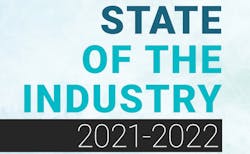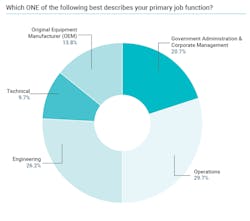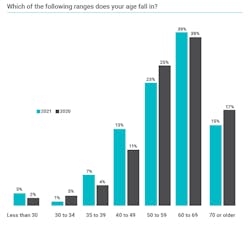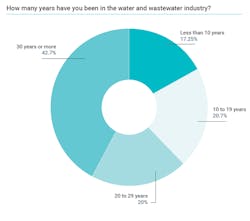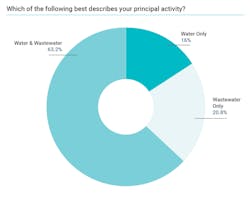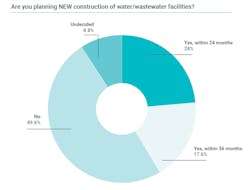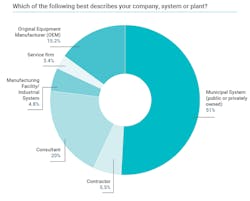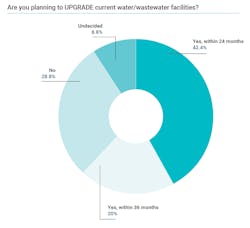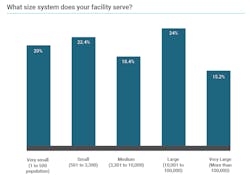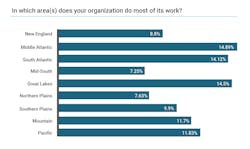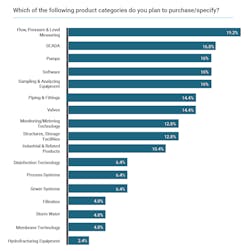State of The Industry 2021 - 2022
Bob Crossen is senior managing editor for Water & Wastes Digest. Crossen can be reached at wwdeditorsgcmail.com.
When reflecting on 2021, it is hard to not see it as one of the most important years for the municipal water and wastewater industry in the past decade or more.
The industry continued to contend with the coronavirus pandemic, saw the publishing and delay of the Lead & Copper Rule, witnessed the proposed Fifth Unregulated Contaminant Monitoring Rule, reflected on poor grades from the American Society of Civil Engineers Infrastructure report card, felt optimistic about President Joe Biden’s American Jobs Plan, and is now preparing for a $55 billion injection from the Infrastructure Investment and Jobs Act.
These federal regulations, rules and laws will create a fundamental difference in the industry moving forward. The momentum is clear, and it is even reflected in the responses to the Water & Wastes Digest Annual State of the Industry Survey.
This report is only a small portion of the State of the Industry Survey Results. Visit wwdmag.com to see the remaining data and charts in their entirety.
Respondent Demographics
This year, 145 members of the WWD audience responded to the survey. Government Administration & Corporate Management accounted for 20.69%; Operations made up 29.66%; Engineering was 26.21% of the respondents; Technical amounted to 9.66%; and Original Equipment Manufacturers (OEM) made up the remaining 13.79%.
As for the sectors in which those respondents work, 63.2% conduct work in both water and wastewater, 16% are water only and 20% only work in wastewater. The principal activity of the respondents’ organizations broke down as follows: Municipal System (public or privately owned) 51.03%; Contractor 5.52%; Consultant 20%; Manufacturing Facility/Industrial System 4.83%; Service firm 3.45%; and OEM 15.17%.
Also notable is the continued trend toward upgrading facilities rather than building new ones. Results showed 24% of respondents over the next 24 months and 17.6% of respondents over the next 36 months would seek new construction. 49.6% said they would not conduct new construction and 8.8% indicated they
were undecided.
Those figures were flipped when it regarded upgrades, however, as 42.4% said they would upgrade within 24 months while 20% said they would upgrade within 36 months. Only 28.8% said upgrades were not on the table, while the same percentage (8.8%) indicated they were undecided. These responses were provided prior to the passage of the IIJA, and it is not clear how or if that funding would impact the responses now.
As for the sizes of the systems, results indicate 20% are Very small (1 to 500 population); 22.4% are Small (501 to 3,300); 18.4% fall into the Medium (3,301 to 10,000) category; 24% are Large (10,001 to 100,000) systems; and 15% indicated they are Very Large (More than 100,000). This is an interesting spread as respondents are evenly distributed across community sizes, although pairing sections together, 60.8% of respondents serve communities of 10,000 people or fewer.
This provides some tangential context to one of the biggest and most important challenges of the year. Smaller systems have smaller workforces, and retaining current workers — let alone hiring them — has been a constant conversation in 2021, and not just in the water industry.
Workforce Retention & Resignation
National news organizations have used the term “The Great Resignation” to refer to the workforce issues seen in 2020 and 2021. After nearly two full years of the coronavirus pandemic, short staffs and increased tension on the work/life balance, employees have been quitting their job en masse. There are some cultural reasons for this as well as societal ones, but important to note are some of the WWD SOTI Survey figures that inform this as well.
Of the 145 respondents to the survey, more than 50% are 60 to 69 years old (38.62%) and 70 years old or older (14.48%). Comparing just those two age ranges to 2020’s report, there was a decrease in those 70 years old or older of nearly 3 points from 17.29%. Additionally the 60 to 69 saw a small increase from 37.97% in 2020. The 50 to 59 age bracket also dropped from 25.19% in 2020 to 22.76% in 2021.
These small changes to the older age brackets redistributed to the bottom of the age curve with sizable increases in 35 to 39 (6.9% in 2021) and 40 to 49 (13.1%), which in 2020 were 4.14% and 10.9%, respectively. Last year, WWD indicated the figures meant people were working later in life and that in doing so, the younger age brackets were unable to move into positions of purchasing authority. Seeing the redistribution this year suggests there have been retirements and promotions of younger industry professionals to fill in the gaps.
But with younger generations will come cultural shifts and changes. Digital products, services and solutions will continue to gain prominence, and younger people are also invested in their jobs if they see their work impacts real change for society at large.
Recruiting and retention strategies will need to change to meet these individuals where they are, and it is already creating challenges for many employers in water and wastewater. WWD has heard numerous anecdotes from OEMs and municipalities alike that if they can even get applicants to apply, getting them to show up for interviews and even show up for the first day on the job are not foregone conclusions. The market place is competitive and without the right values or right pay, workers move to where they see greener grass.
On the note of pay, one of the interesting findings for this survey was in where respondents indicated they would be spending their budget in 2022. While Sewer & Collection Systems led this category with 14.2% indicating they would be spending budget on that infrastructure, the second highest response was Other at 12.19%. Of those responses, around one third indicated they would be spending their budget on wages or salaries in 2022.
For those in a similar boat, it is important to note that the Infrastructure Investment & Jobs Act includes $25 million for the Water Infrastructure and Workforce Investment Grant Program over a five year period. Perhaps with such a grant program, employers in the industry can offer more competitive wages than ever before to entice more workers to the industry.
Optimism in Check
Despite the workforce headwind, respondents to the survey were overwhelmingly optimistic about 2022.
Of the 145 responses, 70% indicated 2021 was a Good (43.45%), Very Good (20%) or Excellent (6.9%) year for their organization. Looking to 2022, those numbers show increased optimism with Good (42.07%) remaining in the same ballpark as 2021 figures, while Very Good (31.72%) and Excellent (9.66%) saw
strong increases.
These responses were taken before President Biden signed the IIJA into law, so it is also safe to say that optimism will be even higher due to the funding increases to programs for the sector. However, that funding does not come without some big hurdles, namely supply chain concerns and the expansion of Buy America language for federal programs.
OEMs throughout the industry have lamented the supply chain issues for their products, which has strained their cash flow and backed up their orders for months at a time. And this will only be further compounded by Buy America language expansion, which requires at least 55% of a product be domestically produced. That number will increase by 5% year-over-year to 80% in 5 years, and OEMs have raised this as a point of concern.
Not only are supply chains strained but domestic iron and steel manufacturing may not be able to meet the demand for domestic products, particularly because Buy America is not limited to the water and wastewater industry. Roads, bridges, rail, airports and all other infrastructure programs will also be subject to this, meaning water resources will be competing against all other infrastructure for materials.
Expect many conversations in 2022 about sourcing materials and opening shipping bottlenecks because without solutions to those problems, the infrastructure funding may be quite the challenge to even spend.
